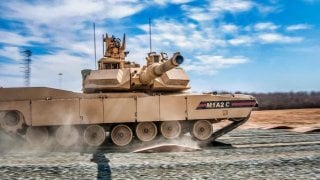The U.S. Army's M1E3 Abrams Tank Is a Nightmare for Russia
In September, the U.S. Army canceled the M1A2 System Enhancement Package version 4 (SEPv4) for the Abrams main battle tank (MBT) and shifted focus to developing the M1E3, aiming to prepare for battlefield threats of the 2040s.
Summary: In September, the U.S. Army canceled the M1A2 System Enhancement Package version 4 (SEPv4) for the Abrams main battle tank (MBT) and shifted focus to developing the M1E3, aiming to prepare for battlefield threats of the 2040s.

-The M1E3 will integrate the best features of SEPv4 while reducing the tank's weight.
-General Dynamics Land Systems (GDLS) received a contract to design the lighter M1E3, intended to complement the M30 Mechanized Infantry Combat Vehicle.
-The Army aims to field both vehicles simultaneously, though challenges remain, including reducing the tank's weight to below 60 tons.
-The development is influenced by lessons from the Ukraine conflict, emphasizing mobility and protection against aerial threats.
M1 Abrams Tank Gets a Revamp: Introducing the Lighter, More Agile M1E3
Last September the United States Army canceled the development of the M1A2 System Enhancement Package version 4 (SEPv4), which was to offer the latest upgrades to the Abrams main battle tank (MBT). The U.S. Army shifted the proverbial gears to focus instead on the M1E3, stating it would "focus on making the capability improvements needed to fight and win against future threats on the battlefield of 2040 and beyond."
As previously reported, the decision to essentially scrap the SEPv4 module and pivot to the M1E3 came following years of testing and analysis, while it listened to operational feedback from those who call the MBT their office on wheels! Rolling forward, the M1E3 is meant to take the best features of the SEPv4, but also offer a slimmed-down Abrams that is ready to face the battlefield threats of the 21st century.
Last month, the U.S. Army awarded General Dynamics Land Systems (GDLS) – the maker of the Abrams – a new contract to begin the preliminary design on the lighter variant, DefenseNews first reported. Over the next year to year and a half, the U.S. Army will work closely with the defense contractor in determining how the new M1E3 should shape up. While it isn't meant to be rushed out, the goal would be for the new MBT to enter service alongside the now-in-development M30 Mechanized Infantry Combat Vehicle.
American Rheinmetall Vehicles (ARV) and GDLS are currently competing for the contract to develop the XM30 vehicle is on track to replace the aging M2 Bradley infantry fighting vehicles that first entered service in the 1980s.
"I think that there would be real goodness for the Army if M30 combat vehicles and M1E3 tanks could be fielded simultaneously to an [armored brigade combat team]," Norman told DefenseNews, adding, "I think the Army senior leaders are going to push us to try to align those schedules, and whether that can be done is an open question right now."
M1 Abrams Tank on a Diet
One factor in ditching the SEPv4 was that for decades, the upgrades on the M1 Abrams simply added more of everything, including armor and advanced equipment. But it also added a lot of weight. The original version of the American M1 MBTs that entered service just over four decades ago weighed in at a relatively lean 67.6 tons, while the current models in service today have beefed up like all too many Americans, with the current model exceeding 73 tons.

The U.S. Army has called for M1E3 to weigh less than 60 tons, but putting the MBT on such a diet will come with challenges that still need to be addressed.
"That might be a little aggressive, but we're pretty ambitious," Norman added. "In order to do that, we anticipate having to change the crew configuration, potentially looking at opportunities to go to a remote turret or an optionally manned turret in order to save the space under armor."
Lessons From Ukraine
U.S. military leaders have also been closely monitoring the massive tank and other vehicle losses that both Russia and Ukraine have seen in the more than two-year-long war, notably how low-cost aerial drones have been employed with great success.
"UAVs are the IEDs of the sky: It's just a mobile IED," a defense industry source who asked not to be named told Breaking Defense. "We spent so much time in Iraq and Afghanistan handling the underbody. … And they're still hitting mines and detracking… [but] crews are surviving."
General Norman also told Breaking Defense that these lessons will help shape the future of the Abrams. He maintained that while the MBT remains well protected against direct fire threats from enemy tanks and other vehicles, it remains vulnerable to top attacks including from anti-tank guided missiles, loitering munitions, and drones.
"The Abrams, and any main battle tank for that matter, is most effective when it can be employed in the offense, or in a situation where they can move around periodically," Norman further emphasized. "It is a mobile protected capability that provides great mobility and firepower and it protects the group. When they stay stationary, they become vulnerable to any number of threats."
Thus it may not just be the Abrams that needs to evolve into a lighter version as the M1E3, but the way it is operated will also need to adapt.
Author Experience and Expertise: Peter Suciu
Peter Suciu is a Michigan-based writer. He has contributed to more than four dozen magazines, newspapers, and websites with over 3,200 published pieces over a twenty-year career in journalism. He regularly writes about military hardware, firearms history, cybersecurity, politics, and international affairs. Peter is also a Contributing Writer for Forbes and Clearance Jobs. You can follow him on Twitter: @PeterSuciu. You can email the author: [email protected].


